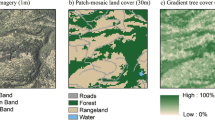Abstract
This paper provides a description of quantitative techniques for visual assessment which are of importance in the selection of sites for least impact for development proposals. Landscape evaluation methods can be grouped into three categories, namely:
-
(a)
Intuitive field based appreciation of landscape scenery
-
(b)
Grading or scaling methods
-
(c)
Statistical techniques such as multiple regressionanalysis as introduced by Warwickshire County Councilin 1971.
Access this chapter
Tax calculation will be finalised at checkout
Purchases are for personal use only
Preview
Unable to display preview. Download preview PDF.
Similar content being viewed by others
References
Warwickshire County Council. Coventry-Solihull-Warwickshire, a Strategy for the Sub-region, Supplementary Report No. 5 ( Warwick, England: Warwickshire County Council, 1971 ).
Fines, K.D. “Landscape Evaluation: A Research Project in- East Sussex”. Regional Studies 2 (l) (1968) tL-55.
Countryside Commission for Scotland. A Planning Classification of Scottish Landscape Resources, CCS Occasional Paper No. 1 (Perth, Scotland: Countryside Commission for Scotland, 1971 ). k. Tandy, C. Landscape Evaluation Techniques (Croydon, England: Land Use Consultants, 1971 ).
Tandy, C. Landscape Evaluation Techniques (Croydon, England: Land Use Consultants, 1971).
Hebblethwaite, R.L. East Hampshire AONB: A Study in Countryside Conservation (Winchester, England: Hampshire County Council, 1968 ).
Weddle, A.E. “Landscape Evaluation: Case Study in the Clyde Estuary”. Journal Royal Town Planning Institute 55 (9) (1969) 387-389,
Robinson, D. et al. Landscape Evaluation: Report of the Landscape Evaluation Research Project (Manchester, England: University of Manchester, 1976 ).
Institut d’Amenagement et d’Urbanisme de la Region dTIlede- France. Methodes d’Evaluation des Caracteres Physiques et Humains du Paysage ( Paris: I.A.U.R.I.F., 1978 ).
Briggs, D.J. and J. France. Environmental Mapping of the European Community: South Yorkshire Case Study (Barnsley, England: South Yorkshire County Council, 1979 ).
Author information
Authors and Affiliations
Editor information
Editors and Affiliations
Rights and permissions
Copyright information
© 1983 Martinus Nijhoff Publishers, The Hague
About this chapter
Cite this chapter
Monbailliu, X. (1983). Current Trends in Landscape Evaluation. In: Environmental Impact Assessment. NATO ASI Series, vol 14. Springer, Dordrecht. https://doi.org/10.1007/978-94-009-6795-3_17
Download citation
DOI: https://doi.org/10.1007/978-94-009-6795-3_17
Publisher Name: Springer, Dordrecht
Print ISBN: 978-94-009-6797-7
Online ISBN: 978-94-009-6795-3
eBook Packages: Springer Book Archive




